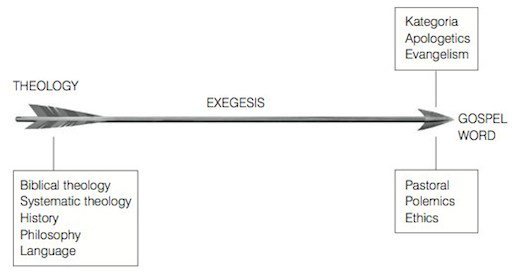The Trellis and the Vine was 2009’s surprise hit (read my review). Written by Collin Marshall and Tony Payne, the book described a ministry mind-shift that the authors assured the reader could change everything–everything related to ministry, that is. The book stood upon its simple metaphor of a trellis, an apparatus used to support something, and of a vine, the object that is supported by that trellis. The trellis referred to the administrative work within a church, those tasks that, though important, are not actually directly related to discipling people. Vine work, on the other hand, is those tasks of working with the vine, drawing people into the kingdom through evangelism and then training them to grow in their knowledge of God and their obedience to him. Though the book may not have been groundbreaking, it somehow managed to pull together a lot of ideas and collect them all within this simple metaphor. It was a powerful and effective combination and it sold very well. Even better, it impacted pastors and those engaged in gospel work, helping them better understand the task the Lord has given them.
The follow-up to The Trellis and the Vine is called The Archer and the Arrow. While it comes from Matthias Media, the same publisher, it is written by different authors: Phillip Jensen and Paul Grimmond. Though the volume is co-authored, its purpose is primarily to make Jensen’s “wisdom about preaching available to a wider audience—wisdom acquired over almost four decades of faithful biblical ministry.” I do not know if the book was conceived as a follow-up to The Trellis and the Vine or not, but regardless, it works as a sequel. Where the first book focused on ministry through a wide lens, the second focuses on the essential heart of ministry–the preaching of the gospel.
The book is framed around what the authors describe as the preacher’s mission statement: “My aim is to preach the gospel by prayerfully expounding the Bible to the people God has given me to love.” They break this statement into its component parts and expound it over the course of several chapters. This takes them from the theoretical to the practical, from the purpose of preaching a sermon to the actual delivery of it.
Let me say a word about the book’s title. The metaphor speaks of the archer (the preacher) and the arrow, which is the sermon. Firing the arrow corresponds to the act of preaching. The arrow itself is formed by three parts–the head, the shaft and the feathers. “At the point of the arrowhead is the gospel, the declaration that Jesus is the Lord and Saviour. The cutting edges of the arrowhead are the implications of that reality. This can include things like ethics, philosophy, apologetics, personal godliness and kategoria.” The shaft corresponds to the exegesis of the passage around which a sermon is formed. And the feathers “correspond to issues like systematic theology, biblical theology, church history, philosophy and the like. The feathers are like the big categories of thought that tie the whole message of the Bible together.”

Where The Trellis and the Vine stood upon its metaphor, where the metaphor itself had great value, The Archer and the Arrow does not, at least in my assessment. The metaphor is simply too complicated, too obscure. Even some of the diagrams supporting it are tough to understand. The beauty of the metaphor of trellis and vine was that it was so simple, so easy to recall and apply. Where The Trellis and the Vine offered a whole new way of wrapping your mind around gospel work, the value of its follow-up will be more in benefiting from the wisdom of a man with decades of experience in the preaching ministry. I would not anticipate too many churches speaking of arrowheads, shafts and feathers in the way they may now speak of trellis work and vine work.
So while the metaphor is not the most compelling, the book’s contents are far more so. Phillip Jensen has a long history of faithful preaching and he has much wisdom to share. It is very helpful to be able to follow along with him not just through the theory of the sermon but through actually putting one together, through wrestling with a text to try to understand it, through looking to the various resources available, and finally delivering that sermon to the congregation. Not all preachers have access to a person who can lead them through such a process, and there is great value in looking in on a pastor like Jensen as he goes about his work.
Let me pause to draw an analogy of my own. Roy Halladay, as you may know, is arguably the best pitcher in baseball. He has already won a Cy Young award and has had many dominating seasons in the past. And yet he continues to try to perfect his technique. He still reads books about the art of pitching and still labors to make himself better. This is a key to his ongoing success. Preachers ought to be much the same, to labor throughout their lives to become better in crafting sermons, in delivering sermons and even in understanding the purpose of sermons. To that end most preachers continue to read books on preaching. And this is just the kind of book that may well prove beneficial to them. It shares no great new technique, no original way of understanding the minister’s task. And that is strength rather than weakness. The book simply calls ministers to faithfully carry out their task and gives them tools to do that in a more biblical way.
If you are a pastor and haven’t yet read The Trellis and the Vine, you will want to do so. And then you will want to read the follow-up as well. The books are a powerful one-two punch looking first to the big picture of ministry and then focusing in on that one area of utmost importance. Colin Marshall (co-author of The Trellis and the Vine) may say it best: “The disciple-making vision of The Trellis and the Vine will only be realized through the kind of fearless, Bible-driven proclamation of the gospel that has been the hallmark of Phillip Jensen’s ministry. For over 20 years I watched him train a generation of young preachers during their ministry apprenticeship. This brilliant book now distils this wisdom for every preacher and would-be preacher.” You cannot have that trellis and vine kind of ministry without faithfulness in the preaching ministry; the two are inseparable, and these books look first to one and then to the other.
You can buy them from Westminster Books: The Archer and the Arrow and The Trellis and the Vine.










